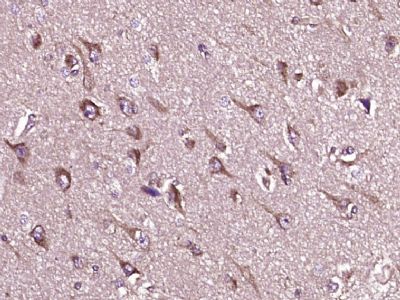NNT Polyclonal Antibody
Purified Rabbit Polyclonal Antibody (Pab)
- SPECIFICATION
- CITATIONS
- PROTOCOLS
- BACKGROUND

Application
| IHC-P, IHC-F, IF, E |
|---|---|
| Primary Accession | Q13423 |
| Reactivity | Rat, Pig, Dog, Bovine |
| Host | Rabbit |
| Clonality | Polyclonal |
| Calculated MW | 109 KDa |
| Physical State | Liquid |
| Immunogen | KLH conjugated synthetic peptide derived from human NNT |
| Epitope Specificity | 981-1086/1086 |
| Isotype | IgG |
| Purity | affinity purified by Protein A |
| Buffer | 0.01M TBS (pH7.4) with 1% BSA, 0.02% Proclin300 and 50% Glycerol. |
| SUBCELLULAR LOCATION | Mitochondrion inner membrane; Multi-pass membrane protein; Matrix side |
| SIMILARITY | In the N-terminal section; belongs to the AlaDH/PNT family. In the C-terminal section; belongs to the PNT beta subunit family. |
| SUBUNIT | Homodimer |
| DISEASE | Defects in NNT are the cause of glucocorticoid deficiency type 4 (GCCD4) [MIM:614736]. A rare, potentially lethal, autosomal recessive disorder characterized by resistance to ACTH action on the adrenal cortex, adrenal insufficiency and an inability of the adrenal cortex to produce cortisol. It usually presents in the neonatal period or in early childhood with episodes of hypoglycemia and other symptoms related to cortisol deficiency, including failure to thrive, recurrent illnesses or infections, convulsions, and shock. In a small number of patients hypoglycemia can be sufficiently severe and persistent that it leads to serious long-term neurological damage or death. The diagnosis is readily confirmed with a low plasma cortisol measurement in the presence of an elevated ACTH level, and normal aldosterone and plasma renin measurements. |
| Important Note | This product as supplied is intended for research use only, not for use in human, therapeutic or diagnostic applications. |
| Background Descriptions | Nicotinamide nucleotide transhydrogenase (NNT) is an integral protein of the inner mitochondrial membrane.It couples hydride transfer between NAD(H) and NADP(+) to proton translocation across the inner mitochondrial membrane. |
| Gene ID | 23530 |
|---|---|
| Other Names | NAD(P) transhydrogenase, mitochondrial, 7.1.1.1, Nicotinamide nucleotide transhydrogenase, Pyridine nucleotide transhydrogenase, NNT |
| Target/Specificity | Widely expressed with expression most readily detectable in adrenal, heart, kidney, thyroid and adipose tissues. |
| Dilution | IHC-P=1:100-500,IHC-F=1:100-500,IF=1:100-500,ELISA=1:5000-10000 |
| Storage | Store at -20 ℃ for one year. Avoid repeated freeze/thaw cycles. When reconstituted in sterile pH 7.4 0.01M PBS or diluent of antibody the antibody is stable for at least two weeks at 2-4 ℃. |
| Name | NNT |
|---|---|
| Function | The transhydrogenation between NADH and NADP is coupled to respiration and ATP hydrolysis and functions as a proton pump across the membrane (By similarity). May play a role in reactive oxygen species (ROS) detoxification in the adrenal gland (PubMed:22634753). |
| Cellular Location | Mitochondrion inner membrane; Multi-pass membrane protein; Matrix side |
| Tissue Location | Widely expressed with expression most readily detectable in adrenal, heart, kidney, thyroid and adipose tissues |

Thousands of laboratories across the world have published research that depended on the performance of antibodies from Abcepta to advance their research. Check out links to articles that cite our products in major peer-reviewed journals, organized by research category.
info@abcepta.com, and receive a free "I Love Antibodies" mug.
Provided below are standard protocols that you may find useful for product applications.
If you have used an Abcepta product and would like to share how it has performed, please click on the "Submit Review" button and provide the requested information. Our staff will examine and post your review and contact you if needed.
If you have any additional inquiries please email technical services at tech@abcepta.com.













 Foundational characteristics of cancer include proliferation, angiogenesis, migration, evasion of apoptosis, and cellular immortality. Find key markers for these cellular processes and antibodies to detect them.
Foundational characteristics of cancer include proliferation, angiogenesis, migration, evasion of apoptosis, and cellular immortality. Find key markers for these cellular processes and antibodies to detect them. The SUMOplot™ Analysis Program predicts and scores sumoylation sites in your protein. SUMOylation is a post-translational modification involved in various cellular processes, such as nuclear-cytosolic transport, transcriptional regulation, apoptosis, protein stability, response to stress, and progression through the cell cycle.
The SUMOplot™ Analysis Program predicts and scores sumoylation sites in your protein. SUMOylation is a post-translational modification involved in various cellular processes, such as nuclear-cytosolic transport, transcriptional regulation, apoptosis, protein stability, response to stress, and progression through the cell cycle. The Autophagy Receptor Motif Plotter predicts and scores autophagy receptor binding sites in your protein. Identifying proteins connected to this pathway is critical to understanding the role of autophagy in physiological as well as pathological processes such as development, differentiation, neurodegenerative diseases, stress, infection, and cancer.
The Autophagy Receptor Motif Plotter predicts and scores autophagy receptor binding sites in your protein. Identifying proteins connected to this pathway is critical to understanding the role of autophagy in physiological as well as pathological processes such as development, differentiation, neurodegenerative diseases, stress, infection, and cancer.


